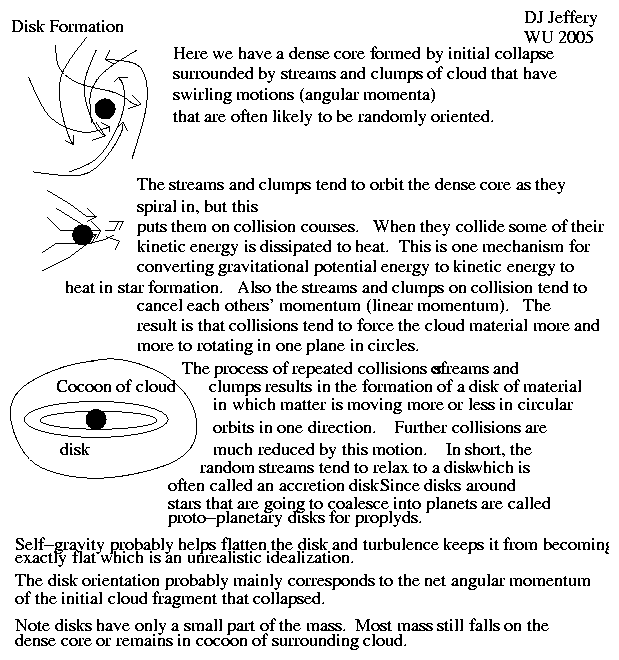
Caption: Cartoon explicating protoplanetary disk formation around a protostar by means of a relaxation process. (FK-172,601--602; HI-271--272).
Features:
- Note that protoplanetary disk
requires some inital
angular momentum
(i.e.,
rotational kinetic energy)
in the molecular cloud
fragment that infalls to make
protostar.
The angular momentum holds up the protoplanetary disk from falling into the protostar. Every little bit of it is in orbit around the protostar.
And there is virtually always angular momentum since there is virtually always sideways motion in space which is what gives rise to angular momentum. A nearly straight-in radial collapse to a protostar is very rare.
- The
protoplanetary disks
formed by the relaxation process can be very thin compared
to their diameters. Probably self-gravity
helps to flatten them.
Random turbulence keeps them from settling to perfectly flat disks
which is an ideal limit.
- The orientation of the
protoplanetary disk
is usually in the equatorial plane of the
protostar:
- The angular momentum of the protostar itself makes the protostar rotate on an axis.
- This gives the protostar a centrifugal force which causes an equatorial bulge.
- The equatorial bulge causes the gravitational field around the protostar to be axisymmetric with symmetry axis aligned with the protostar rotational axis.
- The axisymmetric gravitational field favors the equatorial plane of the protostar. One needs detailed celestial dynamics to calculate the process.
- Thus, the protoplanetary disk tends to align with the equatorial plane.
- Axisymmetric
gravitational fields
of the kind just described may sometimes be the main driver
of protoplanetary disk
formation though the relaxation process is always acting too.
Other kinds of accretion disks (e.g., black hole accretion disks and planetary rings), probably also tend to be aligned by the axisymmetric gravitational field of the central object which arises for the same reason as for protostars. The relaxation process acts too, of course.
In fact, yours truly believes that planetary rings are mostly aligned with the planet equatorial plane of the planet by the planet's axisymmetric gravitational field. However, yours truly CANNOT find a reference that spits out this factoid. As aforesaid, the relaxation process acts too, of course.
Note that in the case of planetary rings, the tidal force of the planet prevents the planetary ring from coalescing under self-gravity into a moon.
For an example of equatorial plane planetary rings, see the rings of Saturn in file saturn_rings_orientation_perspective.html.
- Another complication is that
magnetic field effects
are now known to probably very important in forming
protoplanetary disks.
A full discussion of
magnetic field effects
is beyond our scope.
See Wikipedia:
Magnetorotational instability: Applications and laboratory experiments;
Wikipedia:
Accretion disk: Magnetorotational instability;
Wikipedia: Protoplanetary disk).????
- By the by,
the rotation frequency of molecular cloud
fragment on in-fall typically speeds up.
This is certainly partially due to the PARTIAL conservation of angular momentum as the distribution of the rotating material becomes more compacted. It can't be completely conserved in protoplanetary disks.
Angular momentum depends on mass distribution and rotation frequency (cycles per unit time). If no outside forces act, angular momentum is conserved.
In particular, if the mass distribution of a system becomes more compacted due to internal forces, then frequency must increase to compensate and conserve angular momentum.
- We will NOT go into the detailed
physics of the
conservation of angular momentum,
but it's effects are pretty common if NOT too noticeable in
everyday life.
The speeding up a spinning skater when she/he pulls in arms is an example.
Now for a ---if yours truly can find the equipment---Yes/No.
The old rotating platform and hand masses demonstration is good here. Call for a student volunteer---one who does NOT know the meaning of word fear.
But the figure skater video OpenStax: Angular Momentum V2: Physics Concept Trailer: Figure skater spins | 1:15 is better anyway. See Sport videos below (local link / general link: sport_videos.html):
Local file: local link: protoplanetary_disk_formation.html.
File: Planetary systems file: protoplanetary_disk_formation.html.